Apex Predator
Kevin MacKenzie, aka “MudRat” of www.adirondackmountaineering.com gives us a tour of “Apex Predator” in the remote Panther Gorge
Kevin MacKenzie, aka “MudRat” of www.adirondackmountaineering.com gives us a tour of “Apex Predator” in the remote Panther Gorge
by Alden Pellett
I opened the door to the sound of howling wind, blasting horizontally in front of the cabin loaded with fresh snow that felt like sandpaper on my face. The thought of ice climbing in this harsh below-zero weather made my gut turn. I closed the door, turning to my climbing partner Ryan, “We’re going to need more hot tea.”
For us, that was an early experience on the road to discovering the ice climbing potential in Newfoundland. We had arrived in mid-January that year, learning the hard way by enduring a long sub-zero cold snap with nasty winds that convinced us that it’s better to go later in the season. Before we left on the trip, Joe Terravecchia, one of the earliest pioneers of ice climbing in Newfoundland and whose slide show on climbing in the area had whet our appetites, had not offered up much beta, leaving us to discover what we could as we went.
Motivated by those tales of huge remote ice climbs, my friend Ryan Stefiuk and I had piled all of our climbing gear into my rig and headed out from Vermont. We drove out across Maine, through New Brunswick, and out to the tip of Cape Breton Island in Nova Scotia. There, in North Sydney, as we drove onto the massive overnight ferry late in the evening, a ferry worker motioned us forward as we followed the line of heavily loaded semi-trucks down into the belly of the beast. We awoke the next morning in the upper deck to the sound of ship engines rumbling as we arrived in Port aux Basques, Newfoundland, relieved that we hadn’t experienced one of the legendary boat-tossing, vomit-inducing, heavy sea crossings the route can occasionally produce.
Hunting down where to ice climb in Newfoundland has never been easy. Information on first ascents and route beta has always been difficult to get from previously closemouthed visitors who were possibly hoping to keep the area quiet, to keep potential first ascents to themselves, and to maintain a sense of adventure for others, leaving other first-timers feeling more like they were on an expedition. In fact, this tight-lipped ethic has led to more than one climbing team declaring first ascents, only to find that the routes had been climbed years earlier.
On that first trip ten years ago, Ryan and I eventually found our way to the coastal town of Rocky Harbour. Along the way, the scenic windswept coastal lands scattered with stunted spruce trees that sprouted branches growing only on the downwind side hinted at severe weather. One highway sign along the way warned drivers of poor visibility and dangerous winds over 100 kilometers per hour.
Arriving there in the small fishing village near Gros Morne National Park, we soon learned that the prime area in the region, full of the huge classic ice climbs we had dreamed of, was Ten Mile Pond.
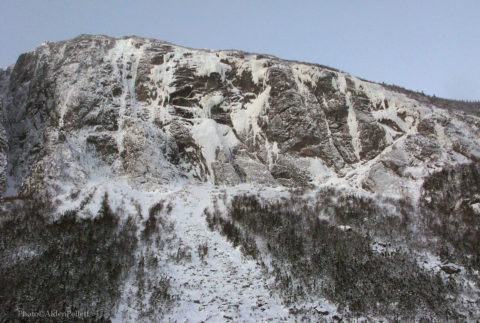
The Cholesterol Wall, a steep wall that is host to a collection of big world-class ice and mixed climbing routes at Newfoundland’s Ten Mile Pond.
This deep freshwater fjord just outside of Rocky Harbour is home to dozens of big classic winter routes of world-class quality, from 600 feet long to near-Alaskan proportions of 2000 feet in length – many of which have only seen one ascent. Each of these stunning routes is every bit as classic as Quebec’s legendary 800-foot La Pomme D’ Or (WI5) or Polar Circus (WI5) in the Canadian Rockies.
The area is also home to the striking Cholesterol Wall, an intimidating steep rock shield often covered in overhanging fat-like ice blobs. The fat theme plays out on routes with names like Fat of the Land and Tundering Lard, both WI5+ and over 800 feet tall.
Thanks to a relatively accessible location with good comfortable lodging nearby and very friendly locals, this beautiful backcountry destination should eventually be on every serious ice climber’s tick list.
To help open the door for NEIce readers to find their way to this incredible spot, and actually enjoy the weather instead of fighting it, we’ve compiled some past stories and photos along with some good beta.

Chat Bots – Al for the Ice Climbers
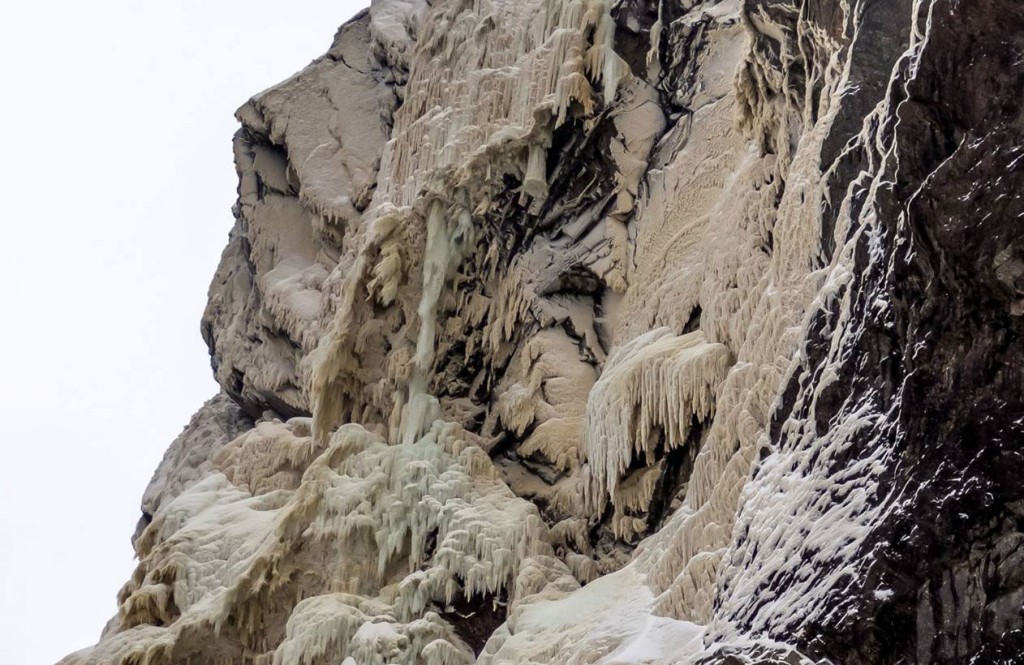
Dreamline (WI6+, 1,260′) February 21, 2017 Gros Morne National Park, Newfoundland, Canada Joe Terravecchia,Will Mayo and Anna Pfaff climbed a new, and spectacular line today, “Dreamline” (WI6+, 1,260′). Dreamline is a spray ice climb to the right of The Pissing Mare Waterfall on Western Brook Pond. Joe and Casey Shaw have been dreaming of, and eyeing this line since 1997, waiting […]
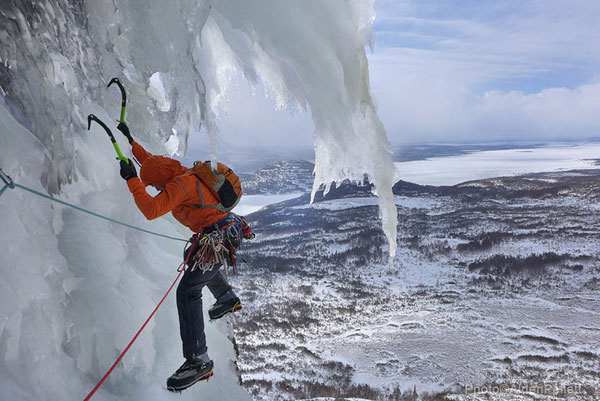
A Trip Report by Ryan Stefiuk – bigfootmountainguides.com The MV (marine vessel) Leif Ericson crunches through sea ice in the Cabot Strait. The ship’s hull groans and 2-3 meter thick ice buckles underneath. Cracks in the ice expose the intimidating midnight blue waters of the North Atlantic. I see the long low hills of the […]
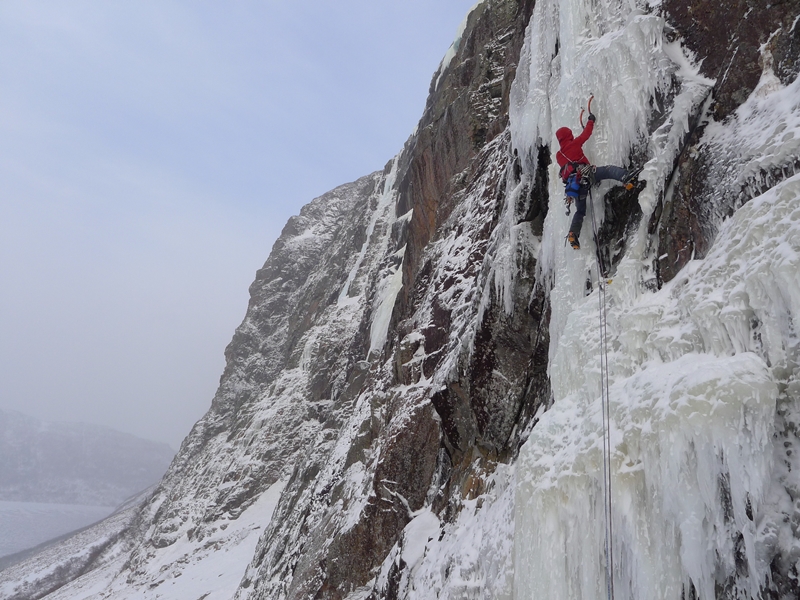
by Ryan Stefiuk I buried my face inside my puffy coat as Andre’s snowmobile lurched into motion. The rubber tread beneath us occasionally slipped on the thick black tiles of ice as we sped along the pond. To my right, Alden and Walt were cruising along, closer to the shoreline. The Cholesterol Wall, looming just […]
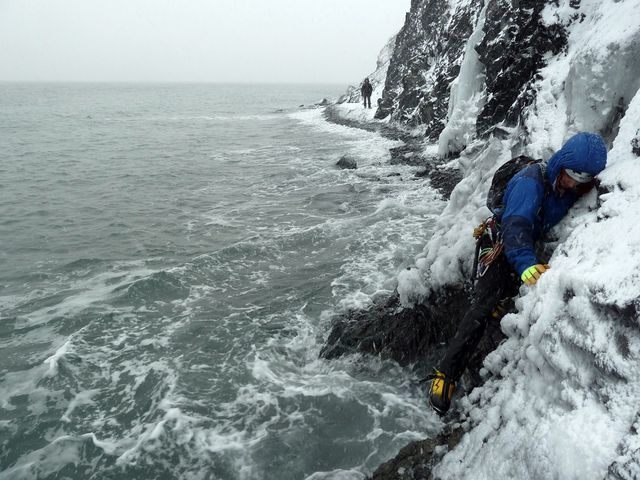
Newfoundland Ice by Michael Wejchert “Walt Nichol, man of few understandable words, slows the snowmobile to a stop about twenty feet form my battered Toyota Corolla and I jump out. For the third time in as many days, Alden Pellett, Ryan Stefiuk and I thank Walt and step out of his cedar sleigh. We’ve all […]
http://www.alpinist.com/doc/web07-08w/newswire-menard-mongrain-newfoundland
http://www.alpinist.com/doc/web15w/newswire-mayo-pfaff-new-route-newfoundland
The best and cheapest way to get to Newfoundland is really to drive your own car. Yes, it’s a long drive!
Otherwise, fly into St. John, NL, and either rent a car there (A nine-hour drive to Rocky Harbour) or arrange an additional flight to Deer Lake, NL, where you can rent a car from any one of the major rental agencies. From there, Rocky Harbour is just an hour away.
If you are coming from most areas of the Northeast, get yourself to Bangor, Maine. From here, it is 550 miles out to North Sydney, Nova Scotia. From Bangor, take Maine State Rte. 9 across the southern part of the state. Cross the Canadian border to follow New Brunswick Rte. 1E (NB-1E) nearing the Bay of Fundy and eventually through Saint John, where the road heads more inland. Near River Glade, merge onto the Trans-Canada Hwy (NB-2E) and continue past Moncton, NB, where the highway starts heading more southerly finally reaching Nova Scotia, where it becomes NS104E. Eventually, the road becomes NS105E. Follow signs for Trans-Canada Highway/Cheticamp/Baddeck/Sydney. In North Sydney, turn right onto Orangedale Road (signs for Marble Mountain/Lona). Turn left onto Portage Road, then turn right onto NS-223 E (signs for Lona/Grand Narrows/North Sydney). Finally, continue onto Seaview Drive/NS-305 N. Once you are in the parking area for the ferry, you will find a terminal with bathrooms. Be prepared for a long wait if seas are rough. It is best to buy your tickets well in advance. You should arrive at least three hours before departure time.
Board the ferry for an overnight journey to Port Aux Basques, Newfoundland. Get your tickets and find the schedule and other information here: https://www.marineatlantic.ca/en/plan-your-travel/ferry-rates/
The Marine Atlantic ferry has overnight cabins with beds and a bathroom/shower, or you can go cheaper and opt for one of the less private bunkbeds. There is a cafeteria serving decent dinners and breakfasts on board. Note that you are not allowed to return to your car in the hold during the voyage, so bring whatever you need up top with you.
Once in Channel-Port aux Basques, Newfoundland, get on Trans-Canada Hwy/NL-1 E from Caribou Road and High Street. Continue through Corner Brook to Deer Lake. In Deer Lake, take NL-430 N eventually coming to views of the ocean in East Arm, fifteen minutes away from Rocky Harbour.
It’s possible to ski in and pitch camp by the fjord if you want. It’s been done, but why suffer? It’s much more enjoyable staying in town and hiring a local person to snowmobile you in for an early start and back out at the end of the day where you can have a shower, a cold beer, and a hot meal after climbing all day. Once in the fjord, the hard part will be deciding which of more than a dozen world-class routes to do that day. One could spend two weeks climbing in Ten Mile and still be left with plenty more to do on your next visit. If you are looking to tick off a first ascent here – good luck! Climbers have been quietly coming here for over twenty-five years. To quote an early first-ascensionist, “We climbed that place silly!” But, if you find an unlikely challenging line that catches your eye, give it a try! You just might get lucky. The ethic established at Ten Mile Pond and other fjords in the region is one of traditional ground-up climbing with no bolting.
On the return trip, we have found it nice timing after leaving the ferry behind, to have dinner and stay in the small town of Antigonish, Nova Scotia.
In Rocky Harbour, we love Gros Morne Cabins. Not too fancy, comfortable, cozy, and an easy walk to the store for beer, food, etc. Kitchen, stove, oven, refrigerator, shower, and wifi. http://grosmornecabins.ca/
Early January can be windy and frigid. For longer days, more ice, and better overall conditions, go in February into early March. It’s mandatory for the inland fjord of Ten Mile Pond to be frozen in order to facilitate easy snowmobile or ski access without having to go over the top of Gros Morne Mountain. Once on the shore of the fjord, it’s generally only a thirty- to forty-minute approach uphill with snowshoes or on frozen neve if conditions are perfect. Weather is a serious topic in Newfoundland. Whiteout snowstorms can sneak up on unsuspecting visitors. Local residents keep close tabs on the forecast, often planning their travels to town around it. If what the locals call “dirty” weather is coming, it’s best to stay close to home or indoors.
There is actually usable cell service at the west end of Ten Mile Pond, so you can call if needed. There is excellent cross-country ski touring and backcountry skiing to be had throughout the region. Ice fishing is a popular local activity along with snowmobiling.
Smaller routes can be found everywhere around the region. Oceanside ice climbing on the cliffs at Cox’s Cove makes an excellent half-day adventure. Be sure to go at low tide.
Zoom, pan and click icons for more information
A Flight along the Big Wall of Mt. Pisgah, Lake Willoughby VT. by “Angel Eyes”. #northeastice
Tyler, where are you from?
I am from the small town of Carthage, New York.
How did you get into climbing?
I have always wanted to do it! But I really began climbing at Houghton College in 2012, where I graduated with a Bachelors of Science in Outdoor Recreation.
What’re your least favorite foods?
Olives. But, I feel like I should acquire their taste before I go on my trip to Italy.
Any snacks you just can’t avoid but know you should? 😊
I eat all the snacks and never look back. Ha,ha.
Favorite food while climbing?
Rock climbing: Donuts. Ice and mixed climbing: Anything warm. Usually miso soup… and donuts.
Any favorite tunes to get psyched for climbing?
Hip hop, rap, or heavy metal. I have been digging Wu Tang, Run the Jewels, Rage Against the Machine and Tool lately.
What is your favorite route in the Northeast?
Paradigm Shift, WI5, M8, at Snake Mountain, Vermont.
What really motivates you to climb hard?
I am honestly mostly motivated by aesthetics and the love of movement. This love for difficult movement tends to encourage me to pursue hard ice and mixed climbing. And it seems most of the beautiful lines are either long ice smears or steep mixed lines that lead to an ice dagger. So I am motivated to climb hard out of necessity! haha
What person has had the biggest influence in your climbing?
Through mentorship; Mikael Williams.
Through inspiration; Ian Osteyee, Josh Warton, and Will Gadd.
You recently sent America’s hardest mixed route, Saphira, M15-, in Vail. Any tips on getting strong for mixed climbing?
My favorite way to train for big roof routes like Saphira, is with gymnastic rings. And big traversing routes also require a good deal of figure 4 training.
What are you using for gear these days?
Tools: CASSIN X-Dreams (aka the greatest tool ever made).
Crampons: CASSIN Bladerunners.
Boots: SCARPA Phantom Tech for ice and mixed, SCARPA Rebel Ice for hard mixed and drytooling.
Other stuff: CAMP Storm Helmet, CAMP Alpine Flash Harness, Camp Nano Carabiners, Petzl or BD screws, Wild Country Friends, DMM Dragons, DMM nuts, any trustworthy thin rope.
Soft goods: Psyched on NW Alpine! They are a small US based company that makes all of their products in Oregon. I try to wear as much of their product as I can to help support a great company. For gloves, I find that the CAMP Gecko Hot has been my all-time favorite for ice and mixed.
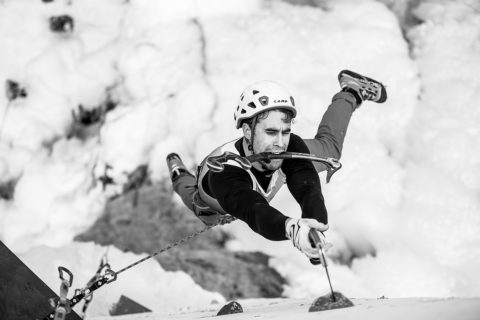
Kempney pulling hard on the upper part of the Mixed Climbing Comp Route during the 2018 Ouray Ice Festival in Colorado. He placed 5th in the Men’s Division. Photo by Mike Thurk (@mthurk)
In 2017, I went to Ouray Ice Festival and watched the competition and from then on I knew I wanted to compete. It looked so fun! Like America Ninja Warrior with ice tools. So I signed up for the 2018 Ouray Ice Fest Competition and finished in 5th place for the Men’s category right behind Will Gadd! I didn’t have any proper training and tried it “off the couch.” Then I thought, “What could I do if I actually trained?”
The American Alpine Club announced that the Ice Climbing World Cup Finals would be in Denver, only 30 minutes from where I currently live. A few of my friends applied to be on the team and we all began training together. This past August, my friends and I found ourselves driving down to Ouray just to go dry tooling. The thought of dry tooling in the summer was funny to me, and it was my first time purely drytooling rather than ice or mixed climbing. But climbing and hanging out with the other competitors was such a great time, I decided to apply for the US team. I honestly just thought it would be a great opportunity to see the world!
As for the team, the US team is still very young. There are a couple members that have competed for a few years, but it isn’t until this year that we have all come together to act as a team. Kendra Stritch, the USA team manager, has been competing for 6 years and has been working with the American Alpine Club to help develop an actual US World Cup team. In years past, it was more like a few individuals representing the US on their own.
Through the persistence of a few team members, we are all really becoming a close-knit team! Our conversations are laced with inside jokes amidst the training and travel plans, and we all get along so well. It truly is a great group of people to help represent the US ice climbing community.
Was learning to ice climb in the Northeast instead of out West important in your skill set?
Yes. In my opinion, the North East will prepare you for ice anywhere out West. But the ice out West won’t prepare you for the ice in the North East. It’s the scrappy nature of the climbs, the tough weather conditions, and the raw amount of high-quality ice in the East. You can’t really get that skill set out here in Colorado. You can become a good dry-tooler for sure. But it would take much longer to become a good ice climber. Here the ice lines are farther apart from one another, there is avalanche danger, and the ice tends to have less water content. Yes we have places like Ouray, Bozeman and Cody. But they are somewhere between six and ten hours away from Boulder, Colorado. That type of drive would get you ANYWHERE out East.
Do you think it’s important for competitors to be able to ice climb?
Unfortunately, no. But for me, yes! I compete because it provides me the opportunity to travel to new places and experience ice in different regions of the world. Plus, ice climbing is my favorite form of climbing.
What’s your most excellent adventure(climbing trip) so far?
The first ascent of Conditional Love on Longs Peak. That route is so aesthetic, rare, and climbed so beautifully, that I climbed it 4 times this season!
What’s on your tick list? – One northeastern route too, please. 😊
Goals this winter: Tick as many of the U.S. test-piece mixed climbs as possible and get in as much ice as possible. I also have a few big objectives that are pretty hush-hush.
Goal this weekend in Bozeman: Inglorious Bastards M12 and House of Flying Daggers M13
Big goal out East: The Fecalator, an M10 trade route, in the Adirondacks. TOP of the list. It always has been. Plus, I have never ice climbed at Lake Willoughby or anywhere in New Hampshire. So my ticklist is HUGE for the Northeast.)
Big goal for drytooling: A Line Above the Sky, D15, in Italy.
Check out a video of Kempney on the F.A. of Conditional Love, WI5+, M5R, on Long’s Peak.
https://www.redbull.com/us-en/ice-smear-climb-colorado
Check out his Instagram feed at tkemp315.
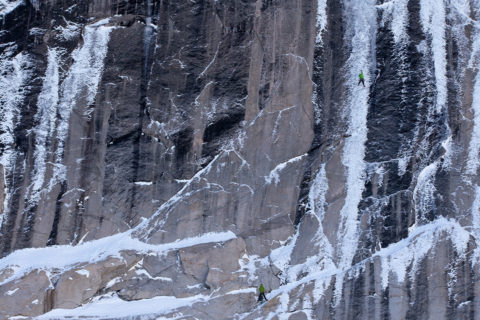
Kempney leading the thin ice smear of “Conditional Love”, M5R, WI5+, on Longs Peak in Colorado. The route was an early season first ascent done by Kempney and Wes Fowler this year. Photo by Drew Herder (@poptop_productions)
Peter Doucette of Mountain Sense Guides and Mike Houser racing the sun on the Bragg-Pheasant / Frankensteins South Face, Crawford Notch NH
11/24/18
The Boston Mountaineering Committee will offer the 2019 Ice Climbing Program this winter. This program teaches waterfall ice climbing and technical mountaineering skills. Prospective students should have rock climbing and winter sports experience. Please attend a mandatory free informational lecture at Arc’Teryx Newbury Street in Boston on Monday, December 3rd at 7 pm (2nd and 3rd lectures for admitted students only on Jan 7th and Feb 4th). The program will be held in the White Mountains on Jan 25-27 and Feb 8-10. Cost is $315 (members) or $375 (non-members). Info: www.amcbostonclimbers.com or ice@amcbostonclimbers.com
An October ascent of the Black Dike is rare, but it is just as rare to find a good balance in your life. Family, work and following your passions. The Doucette / Burhardt family is right on track. After a late night speaking event and the morning logistics of two young children, Peter and Majka still managed to pull off the coveted first ascent of the Black Dike this season. A 10am start “delivered the goods” for them. Another experienced party with an earlier start, backed off the climb that morning. The Black Dike is not in by normal standards and the little window that was there has passed. The ascent is a testament to their ability and balance in their lives.
Find out more on Majka from her website www.majkaburhardt.com/
Photo by Peter Doucette, Mountain Sense Guides
By William Bevans
I climbed smoothly and efficiently through the initial ice bulges on what started out as a bumpy cauliflower pitch of AI3. Not long into my lead on the first technical pitch, I came to a small ledge and took that opportunity to shake my arms out and rest while I looked up for the line of least resistance. It was early morning and the sun just peeked over the horizon. I was perched on the beautiful and tough East Face of Mt. Kidd in the northern Canadian Rockies. The air was dry and cold. Light winds raked the face with snow that had fallen from the prior day. The feeling of being an climber high up on such an amazing line in that setting was a very visceral experience. With my thoughts collected and a small recharge of energy, I moved off the ledge and into a small chimney. I worked the chimney with a series of stems, being content and focused in the moment; finding comfort in the noise of clanging metal from a full rack of screws and ice tools. I laid solid foot placements with my mono-points, working the cracked limestone well, continuing to move well and without issue; and then suddenly, it just happened. I looked down and saw I was quite a distance from my last piece; I then looked up at the remainder of the chimney. It looked grim. What began as good, solid ice thinned into a translucent coating frozen to the rock; verglas. I could see the green lichen underneath the clear coat. Nothing was protectable. I had one leg loaded onto a mono point, my other leg fully extended keeping my stem position. I knew I couldn’t hold it for much longer and I knew I couldn’t down climb.
___________________________________________
It’s coming. Soon it will be the end of October. The sky will be getting dark early, the air will be crisp and we will be waking up to frost all over everything. This combination sparks New England climbers to morph and begin preparing for the ice season ahead. Whatever we did all summer will slowly go to the wayside; we’ll begin scouting cliffs, sharpening our metal, pouring over weather maps and waiting for that steady spell of cold. The winter climbing community will awaken from months of slumber to make trips into the high ravines to see if Pinnacle Gully is in or wait to see who is brave enough to scrap the Black Dike first. Shortly, most of us will be sitting at our 9-5 and get that text from our partner, “You think it’s in? You wanna go?” The beginning of many of our weekend or midweek warrior epics will be here before you know it.
Last season, I saw some amazing climbing feats go down; ones that I wish I could have been a part of but ultimately decided I couldn’t be. It was never easy to volley the text back to my partner and admit my truth: “Sorry, just not feeling it.” or “I just can’t do it.” That was the first winter in over two decades of climbing where I had to turn down a number of trips. I knew I didn’t possess the head game required to climb at those high levels.
___________________________________________
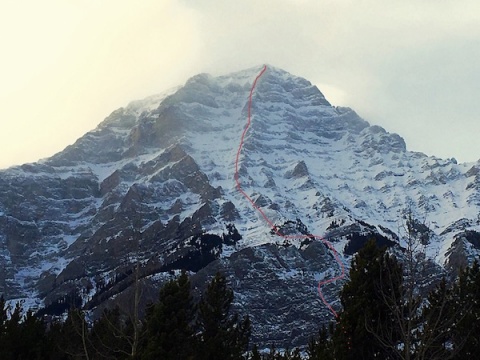
East Face of Mt Kidd, Alberta, Canadian Rockies
It was November 2016. We were in the Canadian Rockies. The season was still young, and like any of us, I was trying to shake out the cobwebs and get on some good pumpy alpine ice. In the Can Rocks, it’s imaginably cold, there isn’t much daylight, the approaches are long, the mountain weather is serious, the terrain is highly technical and the climbing is tough as shit. You can easily see why climbers that hail from this region are absolute beasts. We drove along the dark, cold and snowy I-93 Icefield Parkway just outside Banff. It was some obscure hour in the morning and a natural silence filled our drive. On our docket was the East Face of Mt. Kidd, which may only have seen one successful winter ascent. I found myself trying to get my head straight. ‘Am I gonna be ok? Am I fit enough? Am I really prepared on all fronts to bivy a night out if need be? What the fuck am I actually doing here? Why am I not surfing in Costa? How bad do I really want this? Does this just sound like a good, bad idea?’ I found myself waging the proverbial alpine war, asking myself the tough questions I rather just avoid. You don’t know what’s coming. You don’t even know if it is climbable. You basically have to be as fit as possible and try to battle up it first go the best you can.
Questions unanswered, I began the approach with my partner, working as smartly and efficiently as we could, as there wasn’t much in the way of a trail. It was dark and still very cold out. No matter how much we tried to keep our packs light, they still felt heavy. My body was trying to acclimate to the aches of climbing after a long summer of surfing. Moving along, we tried to make sense of a path by connecting obscure recesses of dirt between patches of fresh snow. I knew if we just got off the trail a little bit, it would set our game off and we’d start doubting things. The calm pre-dawn was interrupted suddenly by an avalanche barreling down the south face of Kidd. Although there was nothing to be seen, the sound was unmistakable. It took a minute, but we shook it off and started moving again. We crossed glacial fed creeks, and trekked in the forest along beautiful, massive cedars and larches as the smell of fresh pine filled the air. We started to feel our engagement in this mission come to life. Our senses filled with adventure and peace from the natural beauty around us. Once the light broke, we found ourselves greeted by the intimidating East Face towering over us in full winter ware. The approach was behind us, and it was time to get real as we started the technical terrain.
___________________________________________
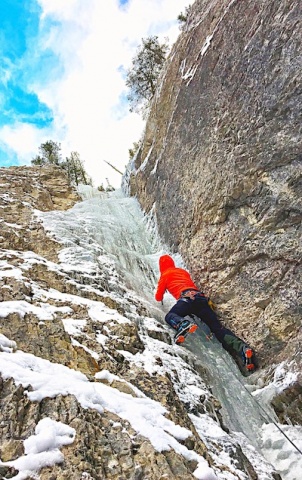
Climbing light ice in Mt. Blaine Canyon
As climbers, we are interested in the grades or ratings of our climbs for they allow us to gauge our ability and give us a somewhat quantitative measure in our advances. We also want to get better and climb harder. Like many young budding ice climbers, I was quick to work up to WI3s and 4s but truth be told it would be many years, hundreds of routes and countless hard lessons before I climbed into the next realm of WI5. Any climber can attest that between these two grades, the parameters change significantly and I would certainly attest that the head scare factor significantly increases in that jump. Being a good climber is one thing; we all know those who climb well have skill, sound technique, and usually an above average degree of fitness. But what does it actually take to climb larger objectives with significant difficulties? Arguably, a climber’s mental strength and conditioning is usually the single most important factor in their potential and their capacity to be successful on advanced difficult climbs. The training regimen or composition of what makes a mentally strong alpinist is not completely understood or it is esoteric at best. A climber with advanced mental conditioning who has committed to creating a bulletproof head is capable of solving complex problems while staying task focused, operating in pretty terrifying conditions all while remaining calm.
___________________________________________
I was surrounded by verglas and caught tight inside this chimney. My eyes moved over every inch of rock and ice as tried to make sense of every possible move sequence I could commit to until I was in a spot of safety. Committing, I went for the “do or die” move. Then, I caught a little spindrift and goofed my placements. I remember hearing metal clang all over like wind chimes while I fell. Several meters of air time passed me by before I bounced off my rest ledge crushing my shoulder. The ledge slowed my fall, but I continued down another 10 meters until I finally, just stopped falling. Hanging there, I remember doing a quick motor drill like, move toes, move fingers, blink, blink, you good? I’m good. I’m good! No major injuries, a few cuts and the adrenaline flowing hard. Now what? Head game damaged, ego beat up a bit and feeling a little humble, I pick myself up and my partner and I limped it back out to the car. Hiking out, I began thinking of the consequences should things have ended up worse. What if I couldn’t walk out? What if this? What if that?
___________________________________________
Mental conditioning could be the single most difficult trait for a climber to improve on. This is especially true after a serious accident, as our climbing psyche can be left damaged, weak or fragile. This is the side of alpinism that we tend to glance over; the psychological and the mental strength dimension of being a climber and specifically, getting back on the sharp end of the rope after an accident. Sometimes our egos get in the way and we don’t talk through those issues. I didn’t really know the extent of how was I affected by my fall until I went climbing in Mt. Blaine Canyon the next day. I get in, everything is looking good; nice grade 3 cruiser. I hop on, start climbing and a few feet up it all starts coming back. I fire in a screw and signal to my partner, “Just lower me.” This would be my head for most of the remainder of the season. At this point, after so many years, countless trips, expeditions, big walls, alpine assaults, and high altitude objectives where I enjoyed the complex head game of being an alpinist, the incredible focus climbing gave me; it all seemed over. After my fall, I got my first taste in what it is like to have lost my head game.
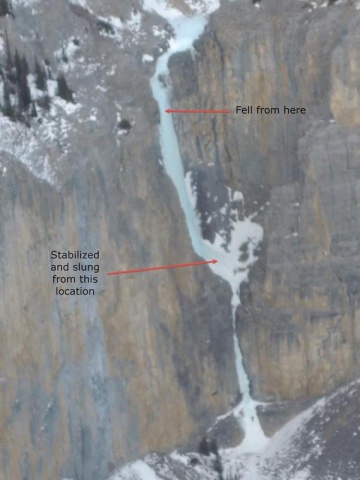
Rescue on Kemosabe. Courtesy of Kananaskis Country Public Safety Section Rescue
An incident that touched closer to home was when highly respected and accomplished Adirondack guide Matt Horner took a serious 20 meter fall last winter shattering several bones in his face. Matt has rebounded quickly and in recent conversation stated he is eager to get back on the ice anticipating only minor tweaks in his game like placing more pro, climbing more cautiously but ultimately no major plans but to go with the flow.
The first major incident where I witnessed a partner lose his head game was a few years ago on an expedition. My partner was an accomplished climber, having ascents on several of the world’s great difficult lines. He is humble, smart, fit and was destined to be a natural and successful leader on our climb. We climbed together for a solid month and I believed we would work seamlessly together to succeed in our upcoming trip. After so much work and several weeks on the go, we finally made it to base camp and we were ready to climb. In Himalayan expedition climbing it is mandatory to complete paperwork regarding the disposal of your body should an accident occur resulting in death. It’s actually quite a head trip to fill out. As we stood staring at the 7,000-meter Himalayan beast in the face, he simply said to us that this wasn’t his trip and he was out. It was the first time I saw someone back down like this, a career defining trip left to the wayside; a sixth sense telling him to walk away. Years later, I still remember that day vividly and respectfully consider it one of the most important lessons I have ever learned; acknowledging and respecting where your head is while climbing.
A mentor imparted on me that climbing in the mountains is really all about how much you are willing to suffer and the answer to that is all in your head. I never really understood that until I started to put together the common themes among my trips; shivering all night in a bivy, eating tasteless gruel day after day, post hole, soul sucking marches across summit fields, being scared shitless 30 feet above your last piece, freezing on a belay ledge and hoping your partner is down to rope gun the crux. Anybody who has done this type II kind of climbing knows that it’s a very deep, inward experience and it’s barely as romantic as it appears on Instagram. It is the type of grind we as climbers are proud of, that gives us character and always has us coming back for more. Everyone has their different reasons why they climb, but our common thread is found in our processes. No matter what discipline you climb in, no matter where in the world you climb, climbers across the world speak the same language. You can climb anywhere in the world and most outings begin and end with striking similarity; morning coffee, catch-up on the approach, a stoked first tool placement, enjoying hard earned views and who ever guns the crux drinks for free that night. For me, many of the toughest and grueling experiences I have been lucky to be a part of have forged the strongest relationships in my life. The dedication to our craft arguably makes our collected commitment to alpinism one of the greatest activities in the world. Co-workers say to me “You’re crazy doing that.” I say “You’re crazy, you watch football all day Sunday.” I really don’t know any other way so I guess crazy is all relative. So as the saying goes “most people prefer comfort forgetting that difficulty is what actually nourishes the human spirit.”
The season is starting soon and we will all be shaking out our summer cobwebs, checking conditions, pondering where the ice is good and trying to put all of the data together to plan a good, safe outing. For newer climbers, trust the process, stay patient and allow your learning to flow through the high and the low points. If you come up short on a climb, don’t let it shake you, everyone has been there. Re-think a different, smarter approach. Learn from your mistakes and always be open to learning from others mistakes. Alpinism is a lifelong study that never ends. There is always something to improve upon. Learn to trust your gut and remember that most of climbing is mental and it’s not any easy game. Remember that everyone at one point or another has had some time where their head wasn’t in the game. When you’re out there, be safe, check on each other, climb within your headspace, have fun and make smart calls so you can rope up and climb another day. See you out there!
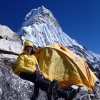
About the Author: William Bevans is a New England based alpinist with over 20 years of experience in the mountains. His studies are concentrated in the area of technical alpine climbing and high altitude mountaineering. He has completed climbs and led expeditions in the Cascades, Rockies, Alps, Himalayas, Andes and big walls in Yosemite, Zion and Mexico. Currently he is involved in mentoring next generation alpinists and climbing the New England classics.
Other articles by the Author: Layering 101
Michael Wejchert, Ryan Driscoll, and Justin Guarino take New Hampshire’s presidential range traverse to a whole new level. – The Technical Traverse.
by Michael Wejchert
I pulled over on the side of the trail: a spot I usually stop with clients to enjoy a lunch break on the third day of Presidential traverses. The rain kept pouring down. We were soaked to the bone. I unzipped Justin’s jacket just a little bit, bent over, and heaved up 400 calories of salami, a liter of water, and the coffee I’d forced down four hours earlier. Ryan and Justin collapsed on their packs. I zipped the jacket back up and wiped my mouth.
“I don’t think I got puke on the jacket, Justin.” It was my first time climbing with him.
Killian Jornet isn’t likely to visit the White Mountains anytime soon. Nobody’s drawn to spruce traps, or short ice climbs, or knobby little summits with weird buildings on top. The terrain isn’t sexy, or long. New Englanders are really great at ice climbing, or climbing on granite, but we’re bad at long days in the mountains; if you want a long alpine day, you’ve got to get really creative. The trick lies in trying to do a lot with a little.
One day, while pouring over the ice-climbing guidebook, I came across Kurt Winkler and Doug Huntley’s “Link ‘em Up,” an enchainment of ice climbs in the Presidentials over three days. I was also deeply impressed with Alan Cattabriga and Gabe Flanders’ efforts to link three ice climbs with a full traverse, from Webster to Madison.
King Ravine, Mad Gulf, the Great Gulf, Huntington Ravine, and Tuckerman’s, all ravines with established climbs, in addition to the nine summits of a standard guided winter traverse: 5,000 feet of climbing or mountaineering, and 27 miles of hiking. I started calling it the “Technical Traverse.” It’d take three days; you’d need to carry a firstlight, a sleeping bag, and food. But then again, while trail running in the Tatra Mountains of Poland a few summers ago, I came across the account of Slovakian Dodo Kopold’s nonstop traverse of the Tatra Mountains, linking up climbs and summits; out went the bivy kit. You’d just need a stove to stay hydrated, a pair of ice tools, crampons, microspikes, (it’s New England), and a puffy jacket!
For three years, I dreamed about pulling off the traverse. Only in the spring, with good snow and perfect neve, would it be possible. Normally, the temptations of clipping bolts in the sun won out. But this year I tore the labrum in my right shoulder on a sport climb. I’d have to hold off on rock climbing until I got surgery, which I opted to do in the springtime. So I just ran a lot, sometimes logging forty to sixty trail-running miles a week. As I guided mountaineering courses and presidential traverses throughout the winter, I piled weight in my pack, often carrying upwards of 65-70 pounds for hours on end, and my legs transformed with that specific mountain endurance you can’t get from Crossfit or trendy stadium workouts.
The warm-up last week was heartbreaking for ice climbers and skiers, and for anyone concerned about our environment. It devastated our snowpack. I went from skiing fresh, perfect powder to guiding in the rain. But it also meant that, if it got cold, even briefly, the entire range would be coated in perfect alpine neve. There was a short window where the temperatures were slightly below freezing, and the wind was quiet enough to warrant speedy moving. Problem was, it would only last about twelve hours before turning to warm, freezing rain. But, if we finished our last climb, we could always suffer through a little rain for the last nine miles of easy walking.
We started hiking at 7:15 a.m., figuring it’d be better to get a full night’s sleep than start super-early. We were in for plenty of night climbing, anyway. We forced ourselves to go slowly up the Valley Way trail, then dumped our packs to drop into Mad Gulf. It was potentially the cruxiest part of the day, but we raced down before the warm sun began melting the ice too much. The ice climbs in the Madison Gulf are awesome: perfect, warm sticks and a beautiful setting. We picked the one Kurt Winkler and Doug Huntley had done on their traverse—a great WI4 line. We trudged up corn snow and summited Madison. Four hours. Good. The sun beat down. We drank from ice melting off the roof of Madison hut, and continued on down into Great Gully in King’s Ravine. This was our easiest climb, and next time I’d opt for “PF Flyer,” something more difficult, though that climb requires bushwhacking that we didn’t have time for. More meltwater, a trudge back up the 600-800 feet or so, to summit Adams. We moved over Jefferson, down into Sphynx col, and spent an hour brewing up more water and eating. Nine hours in. We summited Clay, and dropped into the Great Gulf, and down-climbed perfect neve. We each picked a fun little mixed rib to climb up—the climbing was so much more enjoyable than the hiking, especially without packs. The terrain was classic, easy ravine climbing, with turf-shots, ice, neve, and little mixed bulges. We front-pointed back up to Clay and slogged up Washington. By now, fog was setting in, though it was still clear enough to see town sporadically.
At nightfall, we summited. “We are about to enter the Upside Down,” said Justin, quoting the Netflix show Stranger Things. As the darkness fell, our legs would feel a little more tired, and everything would feel a little bit harder. We down climbed Central Gully into Huntington Ravine, and started up Pinnacle. It was undermined, and actually kind of scary, especially after twelve hours of moving and having three people soloing at the same time. We carefully picked our way up so as not to break the old ice and fall into the waterfall below.
We texted our respective significant others to let them know we were alright, hiked across the Alpine Garden, and bailed into Right Gully in Tuckerman’s Ravine. Another brew stop, taking advantage of the running water by the Ranger Station. We had initially planned on climbing a mixed runnel up the Boott Spur, but we were so exhausted that simply climbing up Hillman’s Highway was good enough. It was ten o’clock. We all felt nauseous as we crunched up the long, terrible slope. The second we reached the top, it began to rain.
We’re in it now. I pulled the GPS out. We couldn’t see fifteen feet. The Upside Down. We’d always thought it’d be over the second we topped out Tuck’s – a victorious slog to the road. My GPS died as we reached Lakes, and we took a compass bearing from the sign. It took us nearly an hour to find the hut from 0.1 miles away. I’ve been there hundreds of times, more than that, in all sorts of weather, but I’ve never encountered fog like that. I headed in a general direction to reach Monroe, where the trail gets easier. I was completely soaked through in my Houdini Jacket and soft shell pants. The down puffy in my pack wouldn’t help much, either. We went from cairn to cairn. If I couldn’t find the trail, I’d yell “Stop!” and the Rhino would hold fast to the last cairn and we’d stretch out as far as we could see each other—a hundred feet or so, and sweep around. It got easier as we wove down the Crawford path, but each time we stopped, I’d start shivering uncontrollably. We were all pretty darn close to hypothermia.
“Michael,” said Justin. “When’s the last time you ate or drank?” He was right. Having three people was starting to seem like a good idea, if for nothing else besides a little bit of control. He gave me his synthetic jacket—a lifesaver. A slog with tired legs over Eisenhower and Pierce, some vomiting (I’m always the one to vomit), and then all we had to do was force ourselves down to the Highland Center. It got warmer in the trees, as the windy, sideways rain gave way to mist. We arrived at 3:30 a.m., twenty hours and fifteen minutes after starting. We’d done it! Ryan started to get excited, “You could do a hut-to-hut traverse with ice gear, and end on the Black Dike!” But, after driving back home, soaked to the bone, all I wanted to do was sleep.
A few more photos:
[ngg_images source=”galleries” container_ids=”74″ display_type=”photocrati-nextgen_basic_thumbnails” override_thumbnail_settings=”0″ thumbnail_width=”240″ thumbnail_height=”160″ thumbnail_crop=”1″ images_per_page=”20″ number_of_columns=”0″ ajax_pagination=”0″ show_all_in_lightbox=”0″ use_imagebrowser_effect=”0″ show_slideshow_link=”0″ slideshow_link_text=”[Show slideshow]” order_by=”sortorder” order_direction=”ASC” returns=”included” maximum_entity_count=”500″]A large size map of the Technical Traverse in PDF by Marc Chauvin
Related Story
Playing Pachinko on Mt- Webster

Your ice climbing connection for New England, the Northeast and Beyond!
